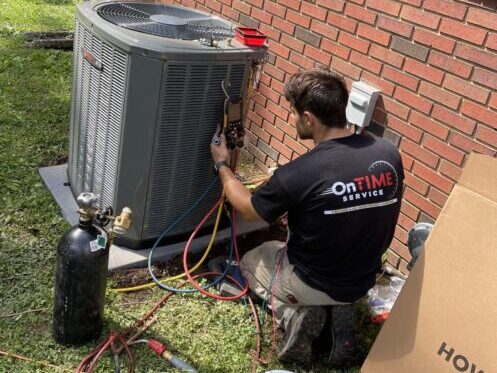By delving into the mechanics behind an air conditioner, you’ll gain a deeper appreciation for the science and engineering that make hot summer days bearable. This knowledge can also be valuable when it comes to troubleshooting issues or maintaining your unit, as it allows you to better comprehend the signals your AC might be giving you about its performance or potential problems.
Working Principle of an Air Conditioner
The primary principle behind air conditioning is the refrigeration cycle. This cycle involves the transfer of heat from one area to another using a refrigerant. The refrigerant, a chemical compound with low boiling and condensing points, undergoes phase changes to facilitate heat transfer. The cycle comprises four stages:
1. Compression
The cycle begins with the compressor, which takes in the refrigerant and squeezes it. This increases its temperature and pressure.
2. Condensation
The high-pressure, high-temperature refrigerant then moves to the condenser, usually located outside your home. Here, the refrigerant releases heat into the surrounding air. As a result, it transforms from a gas into a liquid state, much like how steam condenses into water on a cold surface.
3. Expansion
After condensing, the refrigerant enters the expansion valve, which acts as a gatekeeper, regulating the flow of the refrigerant. As the refrigerant passes through the expansion valve, its pressure and temperature drop significantly. This reduction in pressure causes the refrigerant to cool down rapidly.
4. Evaporation
The now cool refrigerant enters the evaporator located inside your home. As warm air from your space passes over the evaporator’s coils, the refrigerant absorbs heat from the air. This heat absorption cools down the air, which is then circulated back into your room. Meanwhile, the refrigerant changes from a liquid back into a gas, ready to travel to the compressor and start the cycle again.
This continuous process of compression, condensation, expansion, and evaporation allows your air conditioner to remove heat from the indoor air, creating a refreshing and comfortable environment.
Control and Regulation of an Air Conditioner
A thermostat helps maintain the desired temperature within a space by regulating the functioning of the AC system. The thermostat works by sensing the current temperature and comparing it with the desired or set temperature. When the current temperature surpasses the set temperature, the thermostat sends a signal to the air conditioning system to start cooling the room.
Once the room’s temperature drops to the set point, the thermostat again sends a signal to the AC system to stop the cooling process. This on-and-off cycle continues as long as the system is turned on, which helps to maintain a comfortable temperature and prevent excessive cooling.
Energy Efficiency and Environmental Impact
Energy efficiency is a critical consideration when it comes to air conditioners, as they can consume a significant amount of electricity, especially during peak usage periods. One key indicator of energy efficiency in air conditioners is the seasonal energy efficiency ratio (SEER) rating.
The SEER rating represents the cooling output of an air conditioner divided by the energy it consumes over a typical cooling season. Higher SEER ratings indicate greater energy efficiency, meaning the air conditioner can provide more cooling while using less electricity.
Manufacturers have also introduced various energy-saving features to reduce energy consumption. For instance, programmable thermostats enable users to schedule temperature adjustments, ensuring the system operates only when needed. Additionally, the use of eco-friendly refrigerants, such as hydrofluorocarbon (HFC) alternatives, helps minimize the environmental impact of air conditioning systems.
Maintenance and Care of Air Conditioners
With routine AC maintenance, an air conditioner operates at peak performance, enhancing its cooling effectiveness and energy efficiency and ultimately prolonging the lifespan of the unit. Clean filters and coils enable the system to draw in the air more efficiently and exchange heat more effectively, leading to faster and more consistent cooling.
Moreover, when the fins are straight, and the condensate drain is clear, the system can disperse cool air unimpeded and manage humidity levels effectively. Regular thermostat inspections and adjustments guarantee accurate temperature control, ensuring the comfort level in your space is precisely maintained.
Contact AC Professionals Today!
When your AC system isn’t working as it should, it can make your home uncomfortable, disrupt your day, and even increase your energy bills. Whether it’s a sudden breakdown requiring an AC repair or a gradual decline in performance, you need a solution! We’re proud to serve Henderson, KY and the surrounding area, bringing you the best in HVAC services.
We offer repair and installation for all types of cooling systems, including ductless mini splits. We also provide installation and repair of heat pumps and furnaces. Don’t let AC problems disrupt your comfort this summer season. Contact OnTIME Service today and let our technicians return your home to the comfortable haven you deserve.









